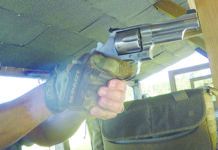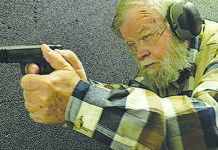
A 22 LR revolver in single or double action can make an excellent trail gun—an inexpensive plinker and plenty of medicine for fisher cats, snakes, and squirrels for the pot. But once you start to hike in the woods and come across bear, wolf, or lion tracks, and the limitations of the 22 LR cartridge become real. Packing more power means a heavier caliber, which translates into a heavier pistol. That lightweight 22 LR may be easy to carry and pack into the back country, but what is required is a handgun that combines light weight with a powerful punch.
Our testers live in a very populated state with pockets of very rural territory where deer and coyote thrive. Occasional news reports of rabid coyotes are not uncommon on local TV. One spring, a black bear walked through the center of town looking for the ripest-smelling garbage can he could find. Even a mountain lion — unheard of this far east — was reported to be on the prowl. And then there are the two-legged predators. For all of these potential threats, some of our testers like 44 calibers, and Gun Tests reader e-mails seem to agree; in fact, we were asked to match up 44-caliber revolvers with 4-inch barrels that are light in weight and well suited for trail work. Add the lightweight criteria to a 44 caliber with a 4-inch barrel and that means a 5-shooter. We were specifically asked to test the Charter Arms Target Bulldog in 44 Special and the new S&W Model 69 in 44 Magnum. The new S&W actually has a 4.25-inch barrel. We also added into the 5-shot face off the Taurus 44 Tracker, which we have reviewed before and found to be a good choice and a useful baseline for comparing the other handguns.
Using a 44 revolver range rod (080-618-044WB, $25) from Brownells, we checked the alignment of the chambers to the barrel in all three new 5-shooters. We assumed they would be in spec and confirmed they were. Cylinder-gap gauges, also from Brownells (60/68 Cylinder Gauge, 080-633-668WB, $36), were used to check the headspace between the rear of the cylinder and the recoil plate. We also used feeler gauges from Brownells (606-950-252WB) to measure the gap between the front of the cylinder and the forcing cone of the barrel. Too close and the revolver will bind because of powder residue; too big a gap, and precious gas is siphoned off, reducing velocity. A gap of 0.003 inches is desirable. The Taurus was the tightest at 0.002 inches, followed by the S&W with 0.005 inches and the Charter Arms at 0.007 inches.
All three had firing pins built into the frame. The Taurus used a transfer bar between the hammer and firing pin while the Charter Arms and S&W used a hammer stop. For added safety, the Taurus and Smith & Wesson had a built-in lock to disable the revolver. A provided key allows the owner to lock and unlock these two guns.
Ammunition selections consisted of 44 Special and 44 Magnum fodder, both of which were used in the 44 Magnum-chambered revolvers. We knew the Charter Arms could not compete in the power category with the two other revolvers, but the 44 Special is a formidable caliber on its own, with a reputation for accuracy and quite a lot of punch. Old-school Remington 44 Special with a lead roundnose 246-grain bullet was used in all three revolvers. Hornady Critical Defense 44 Special loaded with 165-grain FTX bullets clocked close to 1000 fps out of the Target Bulldog. The Smith and Taurus were fed a steady diet of Sellier & Bellot and new Black Hills 44 Magnum ammunition, both loaded with 240-grain jacketed hollowpoints, a sweet-spot bullet weight for this caliber. During the range testing, we found the lightweight 44 Magnums were wrist crackers. Here’s how they performed individually:
Charter Arms Target Bulldog
74440 44 Special, $470
Our testers knew the Charter Arms Bulldog in the 2.5-inch barrel variants. What differentiates the Target Bulldog from the other Bulldog models is 4-inch barrel and adjustable rear sights. The rest is standard Bulldog, and as we have found in previous tests with the Bulldog, it is a well-made revolver for a reasonable price.
The small frame — smaller than those on the Taurus and Smith — meant the Target Bulldog was also lighter. When loaded, the Charter Arms weighed 11 ounces less than the Taurus and 14.2 ounces less than the Smith. Because the Target Bulldog is constructed of a one-piece frame, it was rugged and could take the pounding of the 44 Special. The one-piece frame and full-lug barrel had a matte-stainless finish, which was non-reflective and serviceable. Some minor tool marks showed.
On top was a ramp front sight machined as part of the barrel. The muzzle was crowned as well as rounded off to assist reholstering the pistol. Also at the muzzle was a relief cut along the lug that was attractive and trimmed a bit of weight. The rear sight was finished in a matte-black color, and the notched blade was adjustable for windage and elevation.
The grip was checkered rubber with slight finger grooves that all testers agreed felt good in hand and provided enough traction. The Charter Arms had the thinnest grip of the three revolvers tested, which caused a problem we get into later.
The trigger was smooth in double-action operation, but the feel of the trigger was slightly gritty compared to the slick Taurus and even slicker S&W, but most team members didn’t think twice about it. The extra slickness in the trigger of the other two pistols is what costs extra. The DA pull on the Charter felt the lightest of all three revolvers. The hammer had serrations that provided adequate cocking traction by the thumb. The shooter pushed the cylinder latch forward to swing open the cylinder, and that part worked precisely, with no slop.
Elsewhere, lock up was good; the Charter Arms had about as much wiggle as the Taurus, which was not much. The front of the cylinder face wore a chamfer on the edge, which we liked, and the cylinder was relieved with fat flutes along the circumference. The ejector rod was enclosed under of barrel. Ejecting empties with the Target Bulldog was fast and easy due to the length of the ejector rod, which was knurled at the tip. With all three revolvers, full ejection required gravity assist.
Loading up the Target Bulldog with the old-school Remington cartridges, we found the light weight and small grip resulted in more felt recoil. It was not unmanageable, but it was noticeable, especially with the hot Hornady loads. Still, team members liked firing the Target Bulldog. It loaded easy and fast with the fat 44 Special cartridges, and the ejector dumped empties quickly, though gravity is needed since the ejector rod is not full length so it doesn’t fully eject the cases from the chambers.
The sights were good, though the Taurus and S&W sights were better, we thought. Getting on target fast was not an issue with the Target Bulldog. Accuracy with the Target Bulldog was fair, averaging 2.5-inch groups at 25 yards using a rest. The other two revolvers shot circles around the Target Bulldog, but they are different calibers and at different price points.
The Target Bulldog was not only the lightest of the three 5-shooters, it was the most compact. Wearing it on a belt was effortless. We used both IWB and OWB holsters to carry the Charter Arms around town concealed and along some land-trust trails for a few weeks. We swapped off and on with the Taurus and S&W and found the Target Bulldog to be the most comfortable to carry, followed by the 44 Tracker and then the Model 69.
Our Team Said: The Target Bulldog is a nice 44-caliber revolver for the money; you could get nearly two Target Bulldogs for the cost of the S&W. Accuracy was adequate and felt recoil was manageable. Many testers thought this revolver would be at home in their kit, though some opted for more juice in the 44 Magnum caliber.
Next in order of weight was the Taurus 44 Tracker. This is a solid, well-built revolver with features that separate it from the Target Bulldog and Model 69. First, the 44 Tracker is ported, with four round holes drilled into the bore at about the 11 and 1 oclock positions. The porting made a slight difference in reducing muzzle flip and felt recoil, our shooters said.

The second feature was a front lock-up on the cylinder. In the crane, a semi-circular detent snapped into place in the frame. It made the lock-up on 44 Tracker tight, but it was nowhere near as tight as the Model 69, in our estimation.
Third was the ribbed rubber grip on the 44 Tracker. This is a hand-filling grip with a cushioned palm swell to help reduce felt recoil. In our view, it made the Taurus more comfortable to shoot than the S&W with 44 Magnum loads.
The finish on the 44 Tracker was adequate. We did a double take on the rollmark of the name on the left side of the revolver. The name looked blurred, as if it had been stamped twice. This was an obvious aesthetic flaw that should not have left the factory. Other than that, the finish was executed well. The full-lug barrel and frame wore a matte-stainless finish, while the hammer and trigger had a more polished finish.
Above the porting was a ramp front sight machined into the barrel, with a blade pinned into it. The blade had a red insert, which made it faster to get on target than the Target Bulldog. The matte-black rear sight with a white-outline notch was adjustable for elevation and windage. These sights were a step up from the Target Bulldogs sights, in our view. The barrel used a full lug and shrouded the ejector rod. The muzzle was tapered to assist reholstering, but it wasnt crowned. If we owned the gun, wed crown the barrel immediately since one drop to the muzzle could adversely impact accuracy.
To open the cylinder, the shooter pushed the cylinder latch forward. It worked easily and precisely, as we expected. The latch was finely checkered, providing good purchase when pushed forward with the thumb. The hammer was also checkered and provided a sure grip. The hammer spur was wider and longer than the hammer spur on the Target Bulldog. The trigger was smoother in DA than the Charter Arms, but not as slick as the S&Ws trigger.

The 44 Tracker shot well with the (relatively) inexpensive S&B ammo. It also preferred faster-moving bullets than the Model 69. The 240-grain Sellier & Bellot ammo gave excellent accuracy results at 25 yards. We thought that was due, in part, to the grip and perceived felt recoil – we simply could shoot it better. The Taurus had the opposite reaction to the slower Black Hills ammo and the even slower velocity 44 Special. With slower ammo, the Taurus had accuracy on par with the Charter Arms, which was adequate. The fast stuff was very accurate, which we liked. We actually fired more rounds than our shooting hands appreciated. Shooting 44 magnum rounds, the 44 Tracker had noticeable recoil and was not for the recoil shy.
While loading it, we noted that one of the chambers was harder to load. Perhaps a light touch with a polishing wheel would have opened it up. Like the target Bulldog, the ejector rod required gravitys assistance to have empties fall from the cylinders chambers. Carrying the 44 Tracker was easy with an IWB holster, even though it was bulkier than the Target Bulldog due to the larger girth of the ribbed grip.
Our Team Said: The 44 Tracker has routinely graded well with team members, and this one is no different. For the price, you get a ported barrel and excellent grips to handle the bone-crushing 44 Magnum recoil. We liked it even more because it was accurate even with less-expensive ammo. All told, the one sticky chamber, lack of a crowned muzzle, and double-stamped rollmarks made us mark down this revolver.
The Model 69 Combat Magnum debuted in 2014 and is a departure from S&Ws typical 44 Magnum revolvers. The new Model 69 is built on an L-frame, which Smith brought out in 1980 for the 357 Magnum. An N-frame revolver is S&Ws typical frame used for the 44 Magnum. To fit the caliber in the L-frame, the cylinder capacity was reduced to five shots; N-frames have six shots. There is nothing special in the metallurgy of the L-frame, S&Ws current heat-treating process already makes the metal plenty strong enough to handle the pressures from a 44 Magnum. S&W did, however, have to change the geometry on the cylinder crane so the cylinder would close without hitting the barrel inside the frame.

The Model 69 is constructed of stainless steel and wears a glass-bead-matte-stainless finish. Barrel length is 0.25 inch longer than the other reviewed revolvers. The two-piece barrel was made with a stainless-steel barrel shroud over a steel barrel. Unlike the other two revolvers tested, the Smith used a half lug under the barrel. Even though it uses a half lug, the Model 69 was the heaviest revolver of the trio at 37.2 ounces empty. The top of the barrel was serrated, and at the muzzle was a pinned serrated blade with a red insert. The fully adjustable rear sight also had a white outline around the notch. This was an excellent set up, according to our crew. The top strap of the frame was also drilled and tapped under the rear sight, which could also be removed and an optic attached if so desired.
The trigger, hammer, and cylinder latch were blued and contrasted nicely with the rest of the revolvers finish. The trigger was smooth, and the hammer spur offered plenty of traction to thumb back the hammer and fire in single action. The cylinder latch was precise, and we had no doubt the cylinder was locked up tightly. At the front of the crane was a ball detent that locked into a V-shaped groove in the frame. Team members liked this set-up better than the cylinder lock on the Taurus. We felt it was better built and locked the cylinder into the frame better. With the cylinders swung open, we could also see the spaces between the chambers on the Model 69 and the 44 Tracker were beefier, with more metal, than the Target Bulldog. That was due to the difference in cartridges. The Model 69 also placed the cylinder notches directly between the chambers where there was the most metal. We thought the cylinder was plenty tough. The Smith also had a longer ejector rod than the other two, and it better ejected empty cases.
The Smiths hard-rubber grip with slight finger grooves and a slight palm swell had a nice texture and felt good in the hand for most reviewers. It was more filling than the Target Bulldog and less bulky than the 44 Tracker. It was a full-size grip and was the largest of the three guns tested.
In action, the Model 69 was a pussycat with 44 Special ammo. Recoil was very manageable for experienced shooters, but this is still not a novices revolver. Change to 44 Magnum and the Model 69 was a real wrist cracker, according to some testers. The lighter weight of the L-frame, compared to the typical N-frame, made felt recoil more pronounced with hotter loads than the Taurus, in our estimation.
Accuracy with the new Black Hills ammo was excellent. Using a rest and firing in single-action mode, we were able to shoot groups under an inch at 25 yards. The Model 69 seemed to like the slower bullets. The faster Sellier & Bellot ammo, with a muzzle velocity of 1188 fps, gave larger groups. The Black Hills 44 Magnum and Remington 44 Special clocked at 956 fps and 679 fps, respectively.
We used an OWB holster to carry the Model 69 because it was longer and heavier than the other two revolvers. Carried that way as a trail gun, we liked it. Reviewers thought it would make a great deer gun for use at bow-hunting range. The Model 69 would also be at home hunting black bear over bait or running with dogs.
Our Team Said: The new S&W Model 69 is an excellent revolver thats well made and nicely finished, with very usable sights and a smooth trigger in double action that is also crisp in single action. Irrespective of its heavy price, team members would buy the Model 69 to hang on their belts.
Written and photographed by Robert Sadowski, using
evaluations from Gun Tests team testers. GT
Charter_Arms_Target_Bulldog_74440.pdf
Taurus_44_Tracker_Model_44tracker4SS.pdf
SMITHWESSON_M69_162069_44_MAGNUM849.pdf






















